We’ve told you about the dangers of spiders around the Mediterranean and the even greater dangers of Australia where many of the world’s most venomous creatures live but prepare yourself to be put off from visiting one of the world’s most popular medium haul destinations – Mexico!
Cancun,
Cozumel,
Acapulco,
Puerto Vallarta and more hold obvious attractions for tourists; white sandy beaches, fascinating history and emerald rainforests but visit these at your peril for there are over eighty venomous creatures in Mexico, more than in any other country on earth, and many of them are deadly.
Snakes in Mexico
The Coral Snake
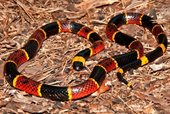
The coral snake is a beautiful creature to catch sight of but that is all you’ll want to do. Varying in colour,it’s easy to recognise having three distinct colour bands. Known locally and ominously as the twenty minute snake, you’ll have twenty minutes before the neurotoxin injected by its fangs paralyses you, causing you to suffocate to death. Anti-venom is available but could you really get hold of it within 20 minutes? The only way to save the life of the victim is to continue artificial respiration until the anti-venom arrives.
Mexico has another similar snake called the milk snake which is almost identical in colour and pattern but this is nature’s imitation of the coral snake and survives because of its disguise as it is harmless.
The Rattlesnake
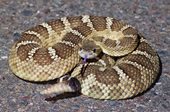
Everyone knows the rattlesnake from old western movies and its reputation is well deserved. Most of the time you’ll be given a warning from the distinctive rattle in its tail as it tries to scare you off. Only if you ignore the warning or stumble on it unawares is it likely to attack but again you’ll have around six hours to save your life. Over three thousand people in Mexico are bitten each year by rattlesnakes but only around thirty die.
Insects in Mexico
Arizona Bark Scorpion
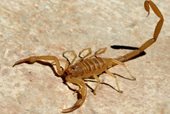
The Arizona Bark Scorpion is quite small, only up to five centimetres long but it
packs a punch. Whilst not fatal to healthy adults, it can cause death in the elderly and the very young. Symptoms include slurred speech, difficulty swallowing, drooling, increased salivation and ultimately respiratory problems which can lead to death.
Visitors to Mexico are recommended to wear shoes, not sandals, at night; check shoes and clothes before putting them on and keep the telephone number of a doctor to hand. If you have young children, it’s recommended that you put the legs of chairs in glass jars as scorpions can’t climb glass surfaces.
Assassin Bug
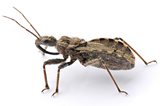
This insect is also known as the Kissing Bug but more on that later. Looking like a harmless beetle, the insect is probably one of the most heinous bugs found on earth. Bites from the insect almost always result in the victims contracting Chagas Disease, thought to affect over 11 million Mexicans. The disease is unremitting in its later symptoms and must be treated before it reaches the acute stage, usually after two weeks. Early symptoms include headaches, diarrhoea, vomiting but peculiarly to the disease; swelling of the eyelids near the bite point.The disease can also be contracted from the faeces of the insect. Later symptoms include swelling of the brain, the arteries and valves around the heart and the digestive tract. Over three thousand people die from the disease each year. Why is it called the Kissing Bug? Because the insect often bites around the mouth of the victim, hence the likelihood of swollen eyes.
The Puss Caterpillar
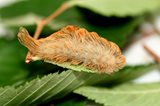
What could possibly be dangerous about a cute furry little caterpillar? Obviously nothing according to the hundreds of children who pick them up to show their parents each year. That’s where holidays and sometimes lives are ruined, for these cute puffy creatures with reddish hairs inject a fatal poison once the hairs penetrate the skin. Cue nausea, blisters, pain in the stomach area, the sensation of being burnt,numbness of the extremities, chest pain, breathing difficulties and then death and you’ll understand why. See a child holding one of these and you’ll need to call for medical assistance urgently.
Spiders in Mexico
Apache Brown Spider
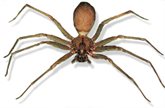
This spider is one of three ‘brown spiders’ which live in Mexico. They look like miniature tarantulas at around 2.5cm long. Just looking at their stocky bodies and thick legs tells you they are going to be trouble and whilst they’re not deadly to the fit, they cause several deaths each year in the young and the elderly.
Black Widow
Reading our articles on spiders around the world you’ll be realising by now that the Black Widow is widespread across the world. Generally not deadly, their bite injects a neurotoxin which causes muscle spasms and the symptoms can be fatal for the old or very young. Easily recognised by their shiny black bodies with the distinctive red marking, they are best avoided rather than inspected!
In the Sea
OK, put aside the possibility of shark attacks and focus more on Salt Water Crocodiles which haunt many of the coastal areas. Survive those and you’ve still got to contend with the venomous Lion Fish whose toxin can cause paralysis and death in the young and old. Many who are stung by their fronds drown from the paralysis. Jellyfish can also cause dangers for swimmers, many are not fatal but will leave you with nasty welts which will burn for days.
Still tempted by the sun, sea and surf of Mexico? Perhaps stick to the safety of your hotel room and
hire a car but don’t forget to check under the bed!
Image source;
Coral Snake - evergladesholidaypark.com
Rattle Snake - scpr.org
Arizona Bark Scorpion - bransonswildworld.com
Assassin Bug - Wikipedia.org
Puss Caterpillar - huffingtonpost.com
Apache Brown Spider - desertusa.com
Black widow Spider - terro.com
Read more from our series of spiders around the world;
Posted:
December 22, 2015
by
Phil Partridge
About the Author -
Travel writer, car rental guru, Phil has rented cars all over the world and shares his knowledge and experience on the Rhinocarhire.com Blog. Favourite country to visit: France.